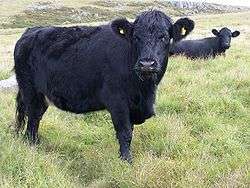Welsh Black cattle

The Welsh Black is a dual-purpose breed of cattle native to Wales.
History
Commercial exploitation of the breed meant that drovers would drive them to English markets. Herds from south west Wales travelled towards Hereford and Gloucester up the Tywi Valley to Llandovery. Herds from South Cardiganshire reached Llandovery through Llanybydder and Llansawel.[1] The drovers would then return to Wales with large amounts of money, which made them targets of bandits and highwaymen. The result was the formation in 1799 of the Banc yr Eidon in Llandovery, the Bank of the Black Ox, which was later purchased by Lloyds Bank.
By the turn of the nineteenth century, 25,000 cattle were being exported from Wales every year. Before the 1960s, few cattle were exported outside the UK, but now can be found in Canada, New Zealand, Australia and Germany as well in Saudi Arabia, Jamaica and Uganda.
Welsh Black cattle are on the list of endangered native breeds in Wales.[2]
Cornish Black
It has been speculated that the extinct black cattle of Cornwall were a closely related breed to the Welsh Black.[3][4] In the nineteenth century they were described as being the same size.[5]
Characteristics
As the name suggests, the cattle are naturally black. They generally have white horns with black tips, but these may be removed, and there are also naturally hornless (polled) strains. Red individuals occur occasionally – red and other colours were more common in the past.
Its hardy nature coupled with its habit of browsing as well as grazing makes it ideal for rough pasture such as heathland and moorland, and for conservation grazing.[6]
Traditionally bred for both milk and beef, commercially it is now usually used only for beef.
Breeding back the aurochs
The aurochs is an extinct type of large wild cattle that inhabited Europe, Asia and North Africa. It is the ancestor of domestic cattle. The species survived in Europe until the last recorded aurochs died in the Jaktorów Forest, Poland in 1627. Approaches that aim to breed back an aurochs-like phenotype do not equate to an aurochs-like genotype. In 2015, researchers mapped the draft genome of a British aurochs dated to 6,750 years before present. Researchers compared the genome to the genomes of 73 modern cattle populations and found in traditional or landrace cattle breeds of Scottish, Irish, Welsh and English origin - such as Highland, Dexter, Kerry, Welsh Black and White Park - carry the ancestry of the sequenced aurochs but the other populations did not.[7][8] Another study concluded that because of this genomic introgression of the aurochs into these breeds, if this reflects "the bigger picture across the aurochs/cattle range, perhaps several sup-populations of aurochs are not extinct at all." The study proposed that it will be possible to consider breeding back Bos "that are genetically akin to specific original aurochs populations, through selective cross-breeding of local cattle breeds bearing local aurochs-genome ancestry."[8]
References
- ↑ Pryse Jones, A. G. (1972). Story of Carmarthenshire.
- ↑ "House of Commons debates, 14 May 2014". Retrieved 14 May 2014.
- ↑ Felius, Marleen (1995). Cattle breeds: an encyclopedia. Misset.
- ↑ Trow-Smith, Robert (2006). A History of British Livestock Husbandry, to 1700. Taylor & Francis.
- ↑ Miller, Philip (1835). The gardeners dictionary.
- ↑ "Welsh Black Cattle Society - Points of the breed". Retrieved 14 May 2014.
- ↑ Park, Stephen D E; Magee, David A.; McGettigan, Paul A.; Teasdale, Matthew D.; Edwards, Ceiridwen J.; Lohan, Amanda J.; Murphy, Alison; Braud, Martin; Donoghue, Mark T.; Liu, Yuan; Chamberlain, Andrew T.; Rue-Albrecht, Kévin; Schroeder, Steven; Spillane, Charles; Tai, Shuaishuai; Bradley, Daniel G.; Sonstegard, Tad S.; Loftus, Brendan J.; Machugh, David E. (2015). "Genome sequencing of the extinct Eurasian wild aurochs, Bos primigenius, illuminates the phylogeography and evolution of cattle". Genome Biology. 16. doi:10.1186/s13059-015-0790-2.
- 1 2 Sinding, Mikkel-Holger S.; Gilbert, M. Thomas P. (2016). "The Draft Genome of Extinct European Aurochs and its Implications for De-Extinction". Open Quaternary. 2. doi:10.5334/oq.25.
External links
- How to Identify Welsh Black Cattle
- Welsh Black Cattle Society
- Oklahoma State University - Breeds of livestock - Welsh Black Cattle